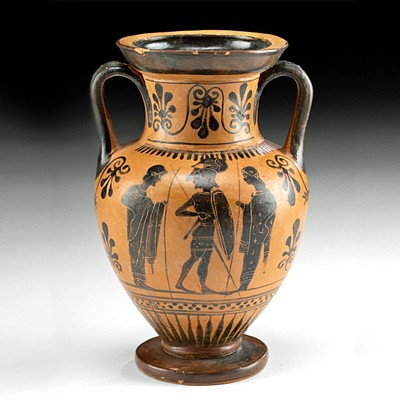Near-Miniature Roman / Parthian Askos, Bull Form
Lot 95a
About Seller
Artemis Gallery
686 S Taylor Ave, Ste 106
Louisville, CO 80027
United States
Selling antiquities, ancient and ethnographic art online since 1993, Artemis Gallery specializes in Classical Antiquities (Egyptian, Greek, Roman, Near Eastern), Asian, Pre-Columbian, African / Tribal / Oceanographic art. Our extensive inventory includes pottery, stone, metal, wood, glass and textil...Read more
Categories
Estimate:
$2,400 - $3,600
Absentee vs Live bid
Two ways to bid:
- Leave a max absentee bid and the platform will bid on your behalf up to your maximum bid during the live auction.
- Bid live during the auction and your bids will be submitted real-time to the auctioneer.
Bid Increments
| Price | Bid Increment |
|---|---|
| $0 | $25 |
| $300 | $50 |
| $1,000 | $100 |
| $2,000 | $250 |
| $5,000 | $500 |
| $10,000 | $1,000 |
| $20,000 | $2,500 |
| $50,000 | $5,000 |
| $100,000 | $10,000 |
| $200,000 | $20,000 |
About Auction
By Artemis Gallery
Mar 9, 2023
Set Reminder
2023-03-09 10:00:00
2023-03-09 10:00:00
America/New_York
Bidsquare
Bidsquare : Exceptional Ancient, Ethnographic, & Fine Art
https://www.bidsquare.com/auctions/artemis-gallery/exceptional-ancient-ethnographic-fine-art-12354
Artemis Gallery info@artemisgallery.com
Artemis Gallery info@artemisgallery.com
- Lot Description
**First Time At Auction**
Roman, Holyland / Parthian, Imperial Period, ca. 2nd to 4th century CE. A miniature bull effigy askos vessel, standing on petite legs with a ring handle and spout set along the body. The bull was considered a deeply divine animal throughout antiquity - a meaningful symbol of the moon, fertility, rebirth, and power. We find the earliest depictions of bulls in Paleolithic cave paintings. Moreover, the veneration of the bull in Anatolia would influence several religious cults in antiquity: from the Minoan practice of bull-jumping in Crete, to the fervent worship of the Apis bull in Egypt, to the sacrificial practices of Roman Mithraism. Note the simplistic geometric forms throughout - cylindrical body and the emphasis on the horns. Ancient Zoroastrian followers believed the earth rested on a rock carried by the Gavaevodata bull; when injured the lunar deity, Mah (Mangha), rescued and purified this primordial bull. Mah's crescent was part of the insignia for Parthian royalty as well. Size: 5.5" L x 2" W x 5" H (14 cm x 5.1 cm x 12.7 cm)
Compare to a similar example on the Metropolitan Museum of Art's website, accession number: 56.156.
Provenance: East Coast collection, New York Gallery, New York City, New York, USA, acquired before 2010
All items legal to buy/sell under U.S. Statute covering cultural patrimony Code 2600, CHAPTER 14, and are guaranteed to be as described or your money back.
A Certificate of Authenticity will accompany all winning bids.
We ship worldwide and handle all shipping in-house for your convenience.
#177306Spout is reattached, stable break line around base. Chips and surface abrasions. Light mineral, and earthen encrustations and remains of painted pigments.Condition
- Shipping Info
-
All shipping is handled in-house for your convenience. Your invoice from Artemis Gallery will include shipping calculation instructions. If in doubt, please inquire BEFORE bidding for estimated shipping costs for individual items.
-
- Buyer's Premium



 EUR
EUR CAD
CAD AUD
AUD GBP
GBP MXN
MXN HKD
HKD CNY
CNY MYR
MYR SEK
SEK SGD
SGD CHF
CHF THB
THB














